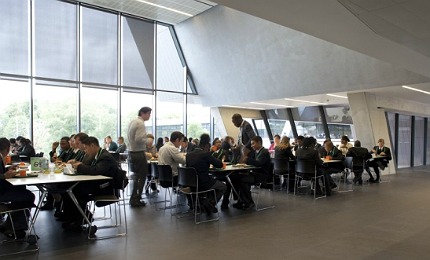
Two years after the controversial scrapping of the UK’s Building Schools for the Future (BSF) programme, new design guidelines have been published to help revamp dilapidated school buildings, but not everybody is happy about them.
The BSF was an ambitious scheme established in 2004 to rebuild every secondary school in the country, reflecting Labour’s priorities for "education, education, education".
But, pressures on architects and local councils to transform schools into sustainable and inspirational environments in a short space of time led to unmet deadlines and over-inflated budgets.
The coalition has replaced the scheme, labelling it wasteful and bureaucratic, with the Priority Schools Building Programme (PSBP), which will see the cost of building secondary schools cut by around £6m.
See Also:
In an era of economic downturn, cost reductions are essential and necessary. The concern, however, is that the need to refurbish schools quickly and cheaply could lead to the pricing out of innovation and a batch of schools that won’t stand the test of time.
How well do you really know your competitors?
Access the most comprehensive Company Profiles on the market, powered by GlobalData. Save hours of research. Gain competitive edge.

Thank you!
Your download email will arrive shortly
Not ready to buy yet? Download a free sample
We are confident about the unique quality of our Company Profiles. However, we want you to make the most beneficial decision for your business, so we offer a free sample that you can download by submitting the below form
By GlobalDataPriority schools baseline designs
Standard design guidance for schools built under the PSBP was published on website of the Department of Education in October 2012.
The baseline designs, developed by the Education Funding Agency (EFA), will cover 261 schools in the UK and help architects and contractors deliver a 30% cost reduction on the schools planned under BSF.
In order to achieve this cost saving, the government has told builders that secondary schools will be 15% smaller than those built during Labour’s spending boom. While maintaining the same size classrooms, staffrooms and art and design facilities, corridors, assembly halls, canteens and atriums will be squeezed under the programme.
The limit on cost per square metre will pose a challenge for contractors. One hope is that they will not use this as an excuse to deprive students of quality working environments.
Martin Mayfield, education business leader and director at Arup believes that making schools 15% smaller without compromising educational attainment needs some real thought.
"My worry is the time that architects have to cut that 15% intelligently is limited. [The programme] presents a risk for each individual project. People will cut corners off in a manner that has consequences that they don’t fully appreciate because they haven’t had the chance to fully engage with the school and understand it," says Mayfield.
"What we have now is a programme that’s accelerated to reduce costs, which I can fully agree with, but what we need to make sure of is that the schools that go into that process have a clear understanding of what they want to achieve out of it. Otherwise, they get railroaded through a process in order to achieve headcount."
Atkins head of education Philip Watkins believes that EFA’s designs promote a "didactic" way of teaching that could have a negative effect on how students learn.
"All the teaching spaces are cellular, there’s no, what I call, blended learning space where you’ve got social spaces which can be used for teaching and learning. It’s gone a bit too traditional for my liking."
Low energy strategies for schools
The government claims that the new blueprints for priority schools will provide a "light, bright and airy" learning environment for students and teachers.
EFA director of capital Mike Green said: "These designs will ensure that new schools can be built to effective designs and specifications, be simple to maintain and energy efficient. And they can be built far faster than many have previously and for far less money."
The Royal Institute of British Architects (RIBA) has welcomed this low-energy environmental strategy, but stresses the success of the layout is predicated on optimal conditions that may be difficult to achieve in reality.
Reacting to the designs, RIBA said in a statement in October: "Relatively minor changes in orientation, internal finishes, or structural systems will significantly affect lighting, ventilation, heat gain and acoustics, which will in turn negatively impact on teaching and learning."
The institute suggests that the environmental strategy be subjected to "rigorous testing" using a range of structural solutions and finishes.
The government is focused on short-term cuts, but longer-term savings through sustainable design have been put to the bottom of the priority list, says Watson.
"If you do passive things like put the building in the right orientation and design the windows so the sun isn’t over-heating the building then those kinds of things come for free."
"But the other measures, which might make the building cheaper to maintain and run and last longer usually cost a little bit more and so guess what happens? Those things don’t get implemented because we haven’t got the money upfront to invest in them," adds Watson.
Simple schools to fit a complicated need
Work on the PSBP is beginning immediately, with the first schools due to open in 2014. The government has already given the go ahead for 15 new schools – and by September 2013, 30 schools are expected to be open across England.
Construction company Wates has trademarked four blueprints costing around £1,450 per square metre, compared to the £2,200 to £2,900 under Labour’s Buildings Schools for the Future programme.
Wates head of education Stephen Beechey told The Guardian: "We will not be producing iconic designs and they will not be shortlisted for the Stirling prize. However, they are good quality buildings that are individual and meet the needs of 21st-century curriculums."
While the PSBP has been criticised for attempting to thwart innovation in schools, it has the potential to promote a more efficient way of building than the BSF scheme.
"I think we were spending too much money on school buildings previously," explains Watson. "The fact is there’s no money in the Treasury and we’ve just got to get on with it and try and build schools with the money that the government has."
Mayfield agrees: "I think that the Building Schools for the Future programme had led to inflated budgets because the aspirations were inflated and the contracts, as they were led, had drawn in transformation in education into essentially what were building contracts."
Priority schools must now provide optimum flexibility to enable designs to meet the needs of individual schools and enable knowledge sharing between communities, contractors, local councils and designers, so all schools benefit.
"When you know what you want, you are prepared to fight for it and you have the information and the knowledge and the conviction to get it right," adds Mayfield.
Related content
Old as the hills: traditional building materials in the 21st century
Materials such as straw, clay and rammed earth have been pushed out of the mainstream by 21st century concrete and steel, but these materials are still a viable option for eco-conscious builds.
The world’s most sustainable buildings
Green buildings are shooting up from the ground as countries race to meet environmental and sustainability targets.




